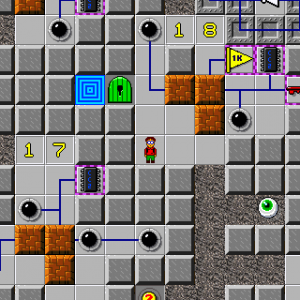Please create an account or Login! Have fun!
Sokoban level: Difference between revisions
Tylersontag (talk | contribs) (CC2 and CC2LP1 examples) |
Flareon350 (talk | contribs) (→Examples of Sokoban levels: added CCLP5 levels) |
||
| (3 intermediate revisions by 3 users not shown) | |||
| Line 5: | Line 5: | ||
The shown level, [[Crazy]], as well as its sequel, [[Crazy II]], are examples; Chip must move three blocks onto three [[black button]]s in each room to collect a [[computer chip]], a [[key]], and a [[bonus flag]]. | The shown level, [[Crazy]], as well as its sequel, [[Crazy II]], are examples; Chip must move three blocks onto three [[black button]]s in each room to collect a [[computer chip]], a [[key]], and a [[bonus flag]]. | ||
Sokoban and Pocoman are two games that work the same way as these levels: the character must move objects onto squares, and then finishes the level when this is done. Therefore, the two terms are often used interchangeably. However, in particular, [[Chips on the Blocks]]'s first section is a direct copy of Pocoman's first level | Sokoban (1982) and Pocoman (1989) are two games that work the same way as these levels: the character must move objects onto squares, and then finishes the level when this is done. Therefore, the two terms are often used interchangeably. However, in particular, [[Chips on the Blocks]]'s first section is a direct copy of Pocoman's first level (which is Sokoban's second level), leading the Pocoman name to be in occasional use. | ||
== Strategies for Sokoban levels == | == Strategies for Sokoban levels == | ||
An additional, | An additional, more generic reference to a Sokoban level is a ''block pushing level'', so principles of block pushing are frequently used. In Crazy and Crazy II, all of the Sokoban sections must be solved quickly to obtain all of the bonus flags; to solve these levels faster, certain rules of Sokoban levels must be applied. The rules of [[Rule of double bridges|double bridges]], [[Rule of turning bridges|turning bridges]], and the [[Block Donut Rule]] and [[Block Retrace Rule]] come in handy as techniques for many Sokoban levels. | ||
== Examples of Sokoban levels == | == Examples of Sokoban levels == | ||
| Line 16: | Line 16: | ||
* [[Seeing Stars]] | * [[Seeing Stars]] | ||
* [[Corridor]] | |||
* [[Writers Block]] | * [[Writers Block]] | ||
* [[Oversea Delivery]] | * [[Oversea Delivery]] | ||
| Line 56: | Line 57: | ||
* [[Construct-a-Sokoban]] | * [[Construct-a-Sokoban]] | ||
* [[Pushover]] | * [[Pushover]] | ||
=== CCLP5 === | |||
* [[Trick or Trap]] | |||
* [[Uphill Battle]] | |||
* [[Mysterious Geoglyph]] | |||
* [[Tornado Alley]] | |||
* [[Sokoban Adventure]] | |||
* [[Shuffling]] | |||
* [[Rundown Railyard]] | |||
* [[Crown Jewels]] | |||
=== CC2 === | === CC2 === | ||
Latest revision as of 04:24, 19 August 2024
A Sokoban level, alternately referred to as a Pocoman level, is a term used to identify a level falling under a specific type of level theme: the movement of blocks onto specific squares to either remove water, bombs, hold down traps, or for some other objective. A Sokoban section means that part of the level holds this property.
The shown level, Crazy, as well as its sequel, Crazy II, are examples; Chip must move three blocks onto three black buttons in each room to collect a computer chip, a key, and a bonus flag.
Sokoban (1982) and Pocoman (1989) are two games that work the same way as these levels: the character must move objects onto squares, and then finishes the level when this is done. Therefore, the two terms are often used interchangeably. However, in particular, Chips on the Blocks's first section is a direct copy of Pocoman's first level (which is Sokoban's second level), leading the Pocoman name to be in occasional use.
Strategies for Sokoban levels[edit]
An additional, more generic reference to a Sokoban level is a block pushing level, so principles of block pushing are frequently used. In Crazy and Crazy II, all of the Sokoban sections must be solved quickly to obtain all of the bonus flags; to solve these levels faster, certain rules of Sokoban levels must be applied. The rules of double bridges, turning bridges, and the Block Donut Rule and Block Retrace Rule come in handy as techniques for many Sokoban levels.
Examples of Sokoban levels[edit]
CC1[edit]
CCLP1[edit]
CCLP2[edit]
- Deconstruction
- Traps I
- Traps II
- Oracle I
- Checkerboard I
- Warehouse I
- Checkerboard II
- Yet Another Puzzle
- Warehouse II
- Switch Hit
- Oracle II
CCLP3[edit]
CCLP4[edit]
CCLP5[edit]
- Trick or Trap
- Uphill Battle
- Mysterious Geoglyph
- Tornado Alley
- Sokoban Adventure
- Shuffling
- Rundown Railyard
- Crown Jewels
